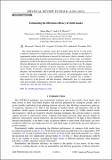Notice
This is not the latest version of this item. The latest version can be found at:https://dspace.mit.edu/handle/1721.1/138819.2
Estimating the filtration efficacy of cloth masks
Author(s)
Mao, Xinyu; Hosoi, AE
DownloadPublished version (2.755Mb)
Publisher Policy
Publisher Policy
Article is made available in accordance with the publisher's policy and may be subject to US copyright law. Please refer to the publisher's site for terms of use.
Terms of use
Metadata
Show full item recordAbstract
The current pandemic has spurred a great deal of debate about the use of cloth masks
as effective alternatives to medical masks for the general public. Despite an abundance of
experimental studies on the filtration of aerosols by cloth masks, there is currently a lack of
analytical understanding to predict mask performance a priori. In this study, we establish a
quantitative model for the pressure drop across woven heterogeneous cloth masks and their
filtration efficiencies for aerosols with aerodynamic diameters less than 1 μm. To compare
the intrinsic filtration capabilities of diverse materials, we introduce a filtration quality
factor. Finally, we present a decision map to illustrate the tradeoffs between filtration
efficiency and breathability and to provide practical guidance on the purchase of cloth
masks. For the most commonly used cotton, polyester, and polypropylene masks, the
mechanical filtration capability is fairly independent of the material, but it exhibits a
high sensitivity to the porosity and fiber diameter. Additionally, keys to a high-quality
cloth mask include a homogeneous structure, micro- or even nanofibrous materials, and a
suitable mass per unit area of the textile.
Date issued
2021-11-05Journal
Physical Review Fluids
Publisher
American Physical Society (APS)
Citation
Mao, Xinyu and Hosoi, AE. 2021. "Estimating the filtration efficacy of cloth masks." Physical Review Fluids, 6 (11).
Version: Final published version